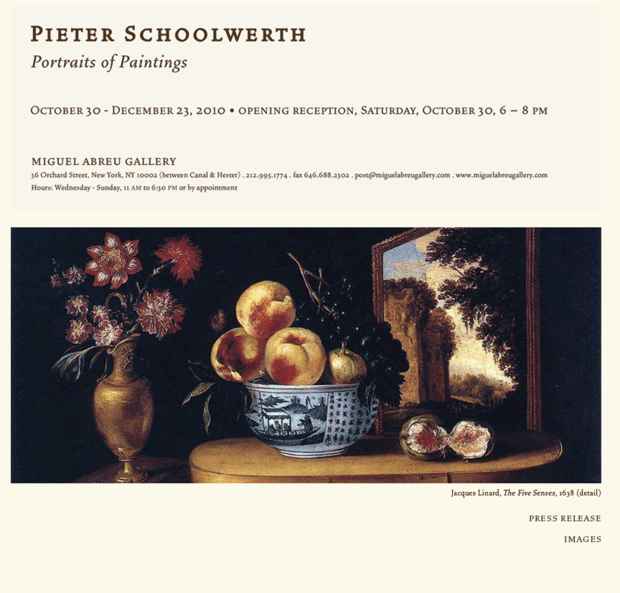Pieter Schoolwerth "Portraits of Paintings"
Miguel Abreu Gallery

This event has ended.
Miguel Abreu Gallery announces the opening on Saturday, October 30th, of Pieter Schoolwerth’s Portraits of Paintings, the artist’s third one-person exhibition at the gallery.
With the six new paintings included in this show, Pieter Schoolwerth further develops his Portraits of Paintings series, and enhances his ‘reworkings’ of old master figure paintings with compressed rearrangements of still lifes and landscapes. As made palpable by his uncannily identical large and small interpretations of Luis Melendez’s, Still Life With Beef, Bowl of Ham and Vegetables, and Receptacles of 1772, Schoolwerth continues to apprehend and keep in check the impulses to both 'critique' and 'express oneself’ through painterly depiction. Instead, he literally uses paintings from the past as the raw material upon which to ground his pictorial operations. As the rubric suggests,
the Portraits of Paintings are allegorical in nature: each work deliberately stages the act of painting and depiction itself.
The process enacted to create every work in the series to date remains essentially the same, yet it has become notably streamlined when compared to Schoolwerth’s preceding efforts. With the figure paintings, for instance, he begins by choosing primarily European pictures from the 16th to the 18th centuries, traces the contours of the multiple figures in the pre-existing image, before isplacing and overlapping the bodies at hand to form a new, single hybridized figure.
In what could be described as a reverse Analytic Cubist effect, in lieu of the articulation of one figure from multiple points of view, what emerges is one perspective on a chimera like mass that results from the superimposition of several bodies, with the head functioning as the central, magnetic point of
compression. As it were, the new imaginary ‘figure’ stands in as a depicted ‘portrait of' the original group.
In Portrait of “The Healing of Tobit” (after Strozzi), Schoolwerth further condenses an already tight scene by the Italian Baroque painter, a biblical allegory of vision in which Tobias, with the help of the Angel Raphael, has applied fish gall to his father’s eyes, and gently pulls off the white patches to restore Tobit’s sight.
Strozzi anticipates the magical narrative slightly by revealing the angel’s identity, which is lost again through Schoolwerth’s act of monstrous scrambling.
Significantly, the fish in the lower right corner of the 17th-century picture, the source of healing of Tobit’s vision, is absent from the new painting. As it were, the work of transformation of the pre-existing visual narrative offers no singular body or subjectivity other than the one afforded by the material action of paint itself. What transpires is a kind of double movement: abstraction followed by re-presentation, or rather extraction and re-incarnation. In the still-lifes, each of the individual depicted objects is drawn and recombined to form a hybridized mass –
which often comes to assume a new 'figural' entity – a singular, often biomorphic object floating amidst the monochromatic 'ground.' The compression of the Melendez composition, for example, produces a shape suggesting a bizarre shoe, etc.
Media
Schedule
from October 30, 2010 to December 23, 2010
Opening Reception on 2010-10-30 from 18:00 to 20:00